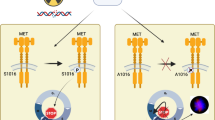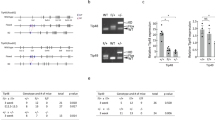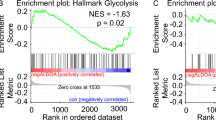Abstract
Cellular responses to DNA damage are mediated by an extensive network of signaling pathways. The ATM protein kinase is a master regulator of the response to double-strand breaks (DSBs), the most cytotoxic DNA lesion caused by ionizing radiation. ATM is the protein missing or inactive in patients with the pleiotropic genetic disorder ataxia-telangiectasia (A-T). A major response to DNA damage is altered expression of numerous genes. While studying gene expression in control and A-T cells following treatment with the radiomimetic chemical neocarzinostatin (NCS), we identified an expressed sequence tag that represented a gene that was induced by DSBs in an ATM-dependent manner. The corresponding cDNA encoded a dual specificity phosphatase of the MAP kinase phosphatase family, MKP-5. MKP-5 dephosphorylates and inactivates the stress-activated MAP kinases JNK and p38. The phosphorylation–dephosphorylation cycle of JNK and p38 by NCS was attenuated in A-T cells. Thus, ATM modulates this cycle in response to DSBs. These results further highlight ATM as a link between the DNA damage response and major signaling pathways involved in proliferative and apoptotic processes.
This is a preview of subscription content, access via your institution
Access options
Subscribe to this journal
Receive 50 print issues and online access
$259.00 per year
only $5.18 per issue
Buy this article
- Purchase on Springer Link
- Instant access to full article PDF
Prices may be subject to local taxes which are calculated during checkout




Similar content being viewed by others
References
Amundson SA, Bittner M, Chen Y, Trent J, Meltzer P, Fornace Jr AJ . 1999 Oncogene 18: 3666–3672
Andegeko Y, Moyal L, Mittelman L, Tsarfaty I, Shiloh Y, Rotman R . 2001 J. Biol. Chem. 276: 38224–38230
Camps M, Nichols A, Arkinstall S . 2000 FASEB J. 14: 6–16
Chen Y-R, Meyer CF, Tan T-H . 1996a J. Biol. Chem. 271: 631–634
Chen Y-R, Tan T-H . 2000 Int. J. Oncol. 16: 651–662
Chen Y-R, Wang X, Tempelton D, Davis RJ, Tan T-H . 1996b J. Biol. Chem. 271: 31929–31936
Davis RJ . 2000 Cell 103: 239–252
Flint AJ, Tiganis T, Badford D, Tonks NK . 1997 Proc. Natl. Acad. Sci. USA 94: 1680–1685
Goldberg IH, Kappen LS . 1995 Enediyne Antibiotics as Antitumor Agents. Borders DB and Doyle TW (eds) Dekker, N.Y pp 327–362
Haneda M, Sugimoto T, Kikkawa R . 1999 Europ. J. Pharmacol. 365: 1–7
Herzog K-H, Chong MJ, Kapsetaki M, Morgan JI, McKinnon PJ . 1998 Science 280: 1089–1091
Ichijo H . 1999 Oncogene 18: 6087–6093
Jelinsky SA, Samson L . 1999 Proc. Natl. Acad. Sci. USA 96: 1486–1491
Karran P . 2000 Curr. Opin. Genet. Dev. 10: 144–150
Kastan MB, Lim D-S . 2000 Nature Rev. Cell Biol. 1: 179–186
Keyse SM, Emslie EA . 1992 Nature 359: 644–645
Kharbanda S, Pandey P, Yamauchi T, Kumar S, Kaneki M, Kumar V, Bharti A, Yuan Z-M, Ghanem L, Rana A, Weichselbaum R, Johnson G, Kufe D . 2000 Mol. Cell Biol. 20: 4979–4989
Lavin MF, Shiloh Y . 1997 Ann. Rev. Immunol. 15: 177–202
Lee SA, Dritschillo A, Jung M . 1998 J. Biol. Chem. 273: 32889–32894
Li N, Banin S, Ouyang H, Li GC, Courtois G, Shiloh Y, Karin M, Rotman G . 2000 J. Biol. Chem. 276: 8898–8903
Liu Y, Gorospe M, Yang C, Holbrook NJ . 1995 J. Biol. Chem. 270: 8377–8380
Lowndes NF, Murguia JR . 2000 Curr. Opin. Genet. Dev. 10: 17–25
Masuda K, Shima H, Kikuchi K, Watanabe Y, Matsuda Y . 2000 Cytogenet. Cell Genet. 90: 71–74
Masuda K, Shima H, Watanabe M, Kikuchi K . 2001 J. Biol. Chem. 276: 39002–39011
Matsuguchi T, Musikacharoen T, Johnson TR, Kraft AS, Yoshikai Y . 2001 Mol. Cell. Biol. 21: 6999–7009
Meltzer B, Hu Y, Sturm G, Wick G, Xu Q . 1998 J. Biol. Chem. 273: 33320–33326
Mielke K, Herdegen T . 2000 Prog. Neurobiol. 61: 45–60
Obata T, Brown GE, Yaffe MB . 2000 Crit. Care Med. 28 : Suppl. N67–N77
Piret B, Schoonbroodt S, Piette J . 1999 Oncogene 18: 2261–2271
Rincon M, Flavell R, Davis R . 2000 Free Radical Biol. Med. 28: 1328–1337
Sanchez-Perez I, Murgia JR, Perona R . 1998 Oncogene 16: 533–540
Schaeffer HJ, Weber MJ . 1999 Mol. Cell. Biol. 19: 2435–2444
Schaus SE, Cavalieri D, Myers AG . 2001 Proc. Natl. Acad. Sci. USA 98: 11075–11080
Schena M, Shalon D, Heller R, Chai R, Brown PO, Davis RW . 1996 Proc. Natl. Acad. Sci. USA 93: 10614–10619
Shafman TD, Saleem A, Kyriakis J, Weichselbaum R, Kharbanda S, Kufe DW . 1995 Cancer Res. 55: 3242–3245
Schmidt-Ullrich RK, Dent P, Grant S, Mikkelsen RB, Valerie K . 2000 Radiat. Res. 153: 245–257
Shiloh Y . 2001 Curr. Opin. Genet. Dev. 11: 71–77
Shiloh Y, Kastan MB . 2001 Adv. Cancer Res. 83: 210–253
Shiloh Y, Tabor E, Becker Y . 1983 Carcinogenesis 4: 1317–1322
Tanoue T, Moriguchi T, Nishida E . 1999 J. Biol. Chem. 274: 18849–19956
Tanoue T, Yamamoto T, Maeda R, Nishida E . 2001 J. Biol. Chem. 276: 26629–26639
Theodosiou A, Smith A, Gillieron C, Arkinstall S, Ashworth A . 1999 Oncogene 18: 6981–6988
Tibbetts RS, Brumbaugh KM, Williams JM, Sarkaria JN, Cliby WA, Shieh S-Y, Taya Y, Prives C, Abraham RT . 1999 Genes Dev. 13: 152–157
Tibbles LA, Woodgate JR . 1999 Cell Mol. Life Sci. 55: 1230–1254
Verheij M, Ruiter GA, Zerp SF, van Blitteswijk WJ, Fuks Z, Haimovitz-Friedman A, Bartelink H . 1998 Radiother. Oncol. 47: 225–232
Wang X, McGown C, Zhao M, He L, Downey JS, Fearns C, Wang Y, Huang S, Han J . 2000 Mol. Cell. Biol. 20: 4543–4552
Widmann C, Gibson S, Jarpe M-B, Johnson GL . 1999 Physiological Rev. 79: 143–180
Acknowledgements
This work was supported by research grants from the A-T Children's Project, the A-T Medical Research Foundation, The Thomas Appeal (A-T Medical Research Trust), and the National Institutes of Health (RO1 NS31763).
Author information
Authors and Affiliations
Corresponding author
Rights and permissions
About this article
Cite this article
Bar-Shira, A., Rashi-Elkeles, S., Zlochover, L. et al. ATM-dependent activation of the gene encoding MAP kinase phosphatase 5 by radiomimetic DNA damage. Oncogene 21, 849–855 (2002). https://doi.org/10.1038/sj.onc.1205127
Received:
Revised:
Accepted:
Published:
Issue Date:
DOI: https://doi.org/10.1038/sj.onc.1205127
Keywords
This article is cited by
-
Kinome screen of ferroptosis reveals a novel role of ATM in regulating iron metabolism
Cell Death & Differentiation (2020)
-
ATM kinase activity modulates ITCH E3-ubiquitin ligase activity
Oncogene (2014)
-
ATM-NFκB axis-driven TIGAR regulates sensitivity of glioma cells to radiomimetics in the presence of TNFα
Cell Death & Disease (2013)
-
Role for Prdx1 as a specific sensor in redox-regulated senescence in breast cancer
Oncogene (2013)
-
Induction of ATF3 by ionizing radiation is mediated via a signaling pathway that includes ATM, Nibrin1, stress-induced MAPkinases and ATF-2
Oncogene (2003)



